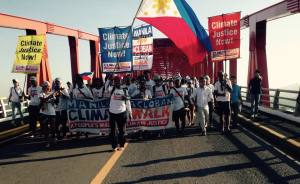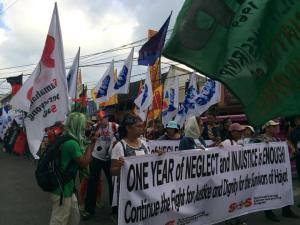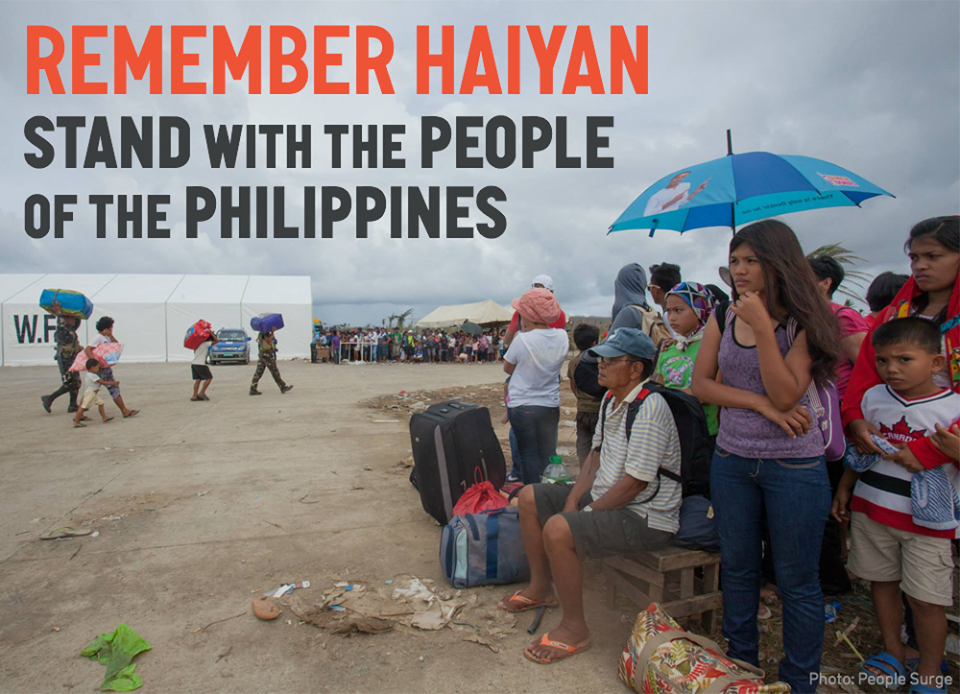
Photo of the Climate Walker as they crossed over San Juanico Bridge to enter Tacloban. Photo by: Chuck Baclagon
Almost a week has passed and we are still reeling. The sunburn has started to peel off, and the calloused soles of our feet have begun to heal. And yet the days of walking went on, as well as the constant singing of Tayo Tayo, and the mental picture of the thousands of people came on and off the Climate Walk. Climate-impacted communities, church people, government representatives and delegations from organizations like Dakila, Oxfam, Aksyon Klima, the Philippine Rural Reconstruction Movement, Greenpeace, the Philippine Movement for Climate Justice, Sanlakas, Buliig Visayas, Partido Kalikasan, Freedom From Debt Coalition, and more who crossed from Samar to Leyte province via the San Juanico Bridge marched toward Tacloban to remember the living and the dead who faced the terror of Typhoon Haiyan.
In Tacloban City, impacted communities and peoples’ organizations belonging to the multi-sectorial formation People Surge held an estimated 15,000 strong march to hold the Philippine government’s accountability of the government’s tepid response to the many that have been affected not only by Haiyan, but by the many recent extreme weather events that hit the archipelago.
The two mass actions highlight a pressing fact for those of us in the climate movement: the fight against catastrophic warming must be won both in the international and local arenas of struggle.

Thousands of people converge in Tacloban for the 2-day protest action to commemorate a year of neglect and injustice. Photo by: Zeph Repollo
The Paradox of generosity & resilience
In the days I’ve spent in the Climate Walk, I noticed that we would not have gone far if not for the Good Samaritans we’ve met along the way. The generosity of strangers from communities, most of them still recovering from recent disasters, is probably the biggest factor as to why we get to eat meals, have places to spend the night and access to running water that enables us to take a bath.
The paradox of it all is that the people whom we meet along the way are the same people who’ve been severely affected by recent disasters. We walked because we wanted to help make their plight known. But what surprises us is that they were the ones who have been very helpful to us – a startling contrast to the contempt shown by the continuing inaction of developed nations who have been historic emitters.
However, what they did was not unique: it was the same acts of kindness that they did for one another during the height of Haiyan’s onslaught. These acts were what allowed them to survive the ordeal and come back more resilient.
But, building resilience should not be the end goal of the walk, nor is it the response to the ever increasing and ever-intensifying impacts of climate change. Science tells us that climate change is the product of more than a century of environmental exploitation of the developed world, chief of which is the burning of fossil fuels to power industries that up to now stir global politics to the favor of corporations.
Speaking truth to power
 If we are to respond to climate change, we need to make it start and end with justice. Climate justice demands that historic polluters be made accountable by making drastic cuts in their greenhouse gas emissions as well as providing the means for those who are already suffering its impacts to adapt to both extreme and slow-onset impacts of climate change.
If we are to respond to climate change, we need to make it start and end with justice. Climate justice demands that historic polluters be made accountable by making drastic cuts in their greenhouse gas emissions as well as providing the means for those who are already suffering its impacts to adapt to both extreme and slow-onset impacts of climate change.
It’s not impossible, if only the money spent on corporate bailouts and on military expenditure to fuel wars are already being spent to develop community based renewable energy, institutionalizing energy efficiency practices and putting resources in means to adapt to the changing climate.
A few weeks from now, climate negotiations will again resume in Peru, and lines again will be drawn between those who are for and against drastic climate action. In those ensuing debates, narratives of people who are already struggling for their non-negotiable right to survive climate change’s impacts might again be swept in the periphery of discussions.
The challenge for the global climate movement is to speak truth to power by reclaiming it in both senses of the word –in energy and in the political arena – because justice demands it: climate change causes drought, floods and other natural disasters that affect food production, it has become one of the greatest threats to reducing poverty, advancing global development and realizing human rights that the world has ever seen. If we do not take urgent and immediate action to make those stories weigh in the discussions, it would be an even more uphill battle for us to push for greater mitigation in the increase of carbon dioxide emissions and in putting into place strong adaptation measures to those vulnerable to climate-induced weather impacts.
Show. Don’t Tell.
I come from an activist tradition that follows Marshall McLuhan’s axiom that the medium is the message. Keeping that in mind means that the action we take should speak louder than the words we utter.
When I was still in Greenpeace, I learned about Bob Hunter, one of its co-founders, who labeled the actions that Greenpeace does as ‘mind bombs.’ Basically, it is a fancy way of saying that the actions that are taken if exposed to a wider audiences spark the desire to ask questions about the way things are, and provide people with inspiring action.
The Climate Walk is a good example of a mind bomb because walking is a prime example of how we can move away from our collective dependence on fossil fuels, given that much of the oil that are burned are used in unsustainable transportation: by seizing the road and walking to our destination, no cars–no shortcuts–just the conviction to arrive at our destination.
Going beyond Tacloban
Now, after the days of walking towards Tacloban, most of us are back home in Manila, working against time to make the most of the gains that we were able to secure in the Climate Walk. Yeb Sano, (who conceived and led the Climate Walk) notes: “We are under no illusions that the walk will change anything [in the climate change fight] overnight, but it is raising awareness… At the least, every person whom we have encountered, we can safely say we have converted on climate change action, and they will become local environmental heroes in their own communities”
The challenge is to put pressure for a concerted global response to climate change, while at the same time, for people in vulnerable countries like the Philippines to push for greater accountability and transparent leadership in their governments, because theirs is the burden to stir the country towards survival and resilience.
In this seemingly overwhelming realization, we can find hope in the words of Yeb as he highlights the value of the seeds that were planted in the walk when he says: “Our real destination is the hearts and minds of Filipinos and people all over the world—hearts and minds that can change the world.”
The Climate Walk is a step toward that direction. And to use the words that our alpha walker uses to get us moving during the walk, our work is now to “push” towards our destination.
In the week prior to commemorating the 1st year of Typhoon Haiyan’s landfall in Tacloban, 350.org supported both: the Climate Walk, which walked from Manila to Tacloban to stand with those suffering in the climate crisis and holding the historic emitters accountable for climate damages. As well as People Surge’s 2-day series of protest activities that is aimed at holding their holding the Philippine government responsible for its tepid response to recent extreme weather disasters.
